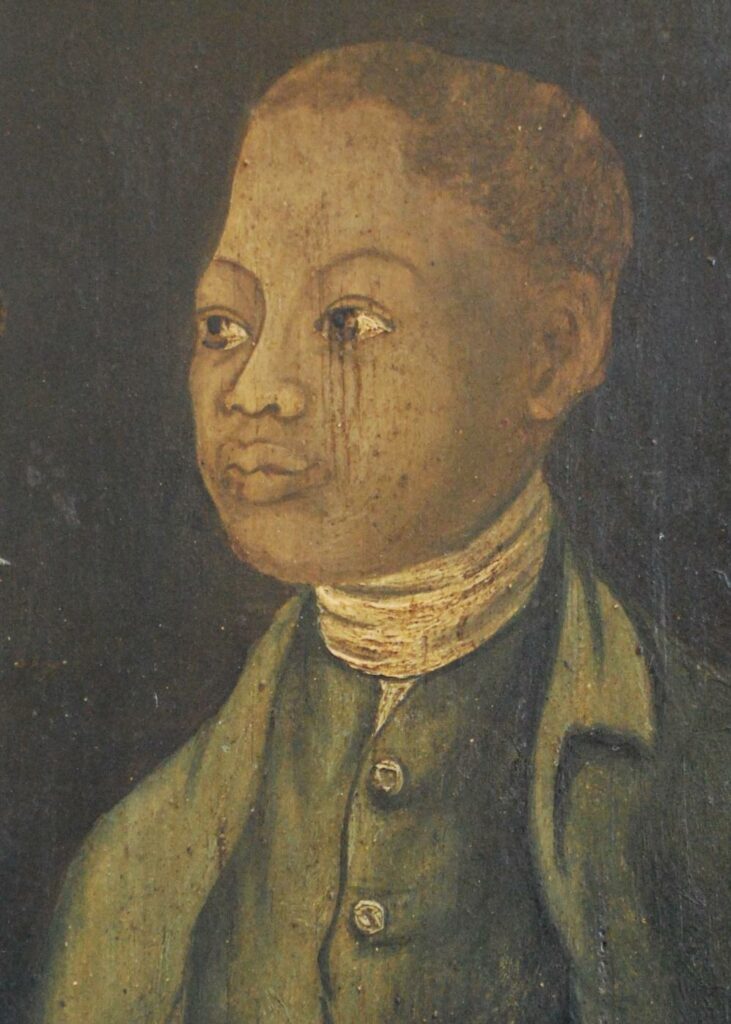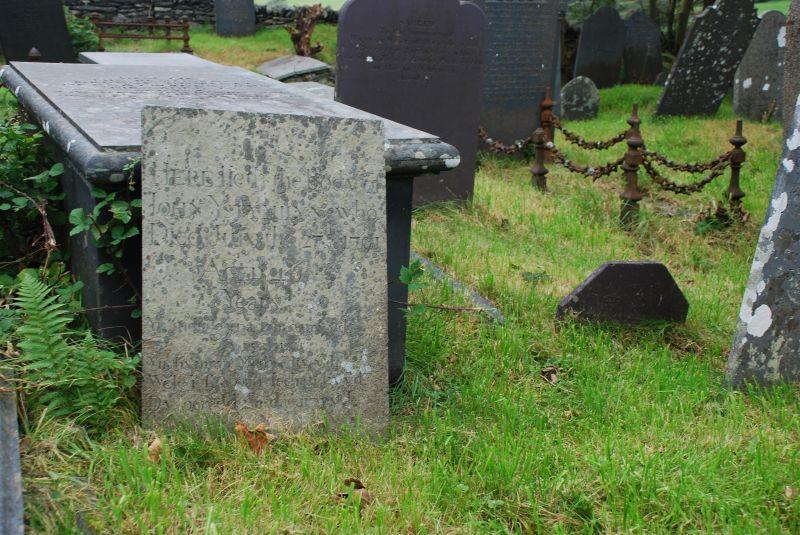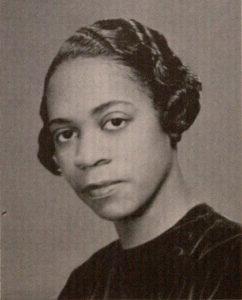John Ystumllyn was an 18th century gardener and the first well-recorded Black person in North Wales. He and his wife Margaret are also the first recorded interracial Welsh married couple.
He was abducted as a boy possibly from West Africa and became a servant to the Wynne family of Ystumllyn, whose estate he was named after. He learned horticulture and floristry in the gardens there.
In 1888 he was the subject of a pamphlet by Robert Isaac Jones (Alltud Eifion. ) There is also a painting of him as a young man, and a monument to him at St Cynhaern’s church where he is buried. How John came to be in Wales is unclear, but he came to be a man “respected by the gentry and the common folk alike” (Eifion)
In 2021, John became the first Black Briton to have a rose named after him, in celebration of his life. Zehra Zaidi is founder of the campaign group We Built Britain Too and approached Harkness Roses with the idea for the rose. Writing for Horticulture Week magazine she describes the rose as “a symbol of friendship, love and community because that’s what John’s story represented…”
Jac Du or Jac Black
c. 1738
9 July 1786
Died of Jaundice. Buried at St Cynhaern’s Church, Ynyscynhaearn, Gwynedd, Wales.
A sandstone monument was later erected at his gravesite to commemorate him. This became a Grade II listed building in 1999.
Africa
African
Our information about John comes from a pamphlet published in 1888, almost 100 years after he died, written by Alltud Eifion. He was the grandson of the doctor who had cared for John Ystumllyn in his final days and wrote about this remarkable man from oral accounts. As is the case when a source is so removed from the subject, it is not entirely reliable. The pamphlet was translated from Welsh to English in sometime in the mid-20th century, (author unknown but an unverified source credits it to D. Trevor Roberts) entitled:
“John Ystumllyn or ‘Jack Black’: the history of his life and traditions about him since his capture in the wilds of Africa until his death; his descendants, etc. etc., together with a picture of him in the year 1754”.
Little is known of John’s early life. Eifion offers some theories, but cites John’s own words:
‘…he was on the banks of a stream amid woodland attempting to catch a moorhen when white men arrived and caught him and took him away with them to the ship’.
We do not know precisely how, but John came to live with the Wynne family on the Ystumllyn estate in Criccieth, where they assigned his new name. His age at this time is given variously as 8 or 13, with the date of the painting we have of 1754 purportedly showing him at 16.
There is a view that John was an enslaved child brought to Britain from the West Indies, which seems to be supported by the wording of an Englyn (a traditional Welsh short poem form) by Dafydd Siôn Siâms, Penrhyndeudraeth, engraved on John’s tombstone. This notes that he was ‘born in India’ and baptized and buried in Wales. This could be a reference to the West Indies. Andrew Green, a past Librarian of the National Library of Wales, has a transcription and translation of the verse on his blog:
Yn India gyna fe’m ganwyd – a ngamrau
Ynghymru medyddiyd;
Wele’r fan dan lechan lwyd
Dy oeredd im daerwyd
Born in India, to Wales I came
To be baptised
See this spot, a grey slate marks
My cold resting place
Despite this traumatic introduction to Wales, and what Eifion describes disparagingly as
“…considerable difficulty for a long time in domesticating him,”
John learnt to speak and write in both Welsh and English and was set to work on the estate’s gardens. According to Dr Marian Gwyn in an interview quoted by ‘The Guardian’ newspaper, records showed that he was not subsequently enslaved and lived as a free man.
According to Eifion, he became a talented horticulturist and craftsman:
“He was placed in the garden to learn horticulture, which he did more or less perfectly, as he was very ingenious. He could turn his hand to almost anything he saw someone else do, such as making small boats, wooden spoons, wicker baskets etc. He was also very fond of flowers and a good florist.”
His professional life isn’t detailed any further than that he worked as a gardener or land-steward consistently for over thirty years. The details are caught up in his personal life and courtship of Margaret Gruffydd, a maid at Ystumllyn who would become his wife.
He lost his place at Ystumllyn when he followed Margaret to Dolgellau where they were married, in 1768. John would have been 20 at this time. After their elopement, they found employment as Land Stewards at Ynysgain Fawr. Some reconciliation took place with the Wynne family, as he did get his place back at Ystumllyn. The Wynne family gifted him a cottage called Y Nhyra Isa, with a large garden and a field in front in honour of his service. At the time of his death, he was employed by a branch of the family at Maesyneuoedd.
Margaret Gruffydd worked as a maid for the Wynne family, and would take bread, cheese, and ale to John for his lunch when he was working in the estate grounds. When Margaret moved to Eifionydd for another job, John would visit her to continue their courtship, clearly successfully as they eventually eloped. The two were married at Dolgellau, on 9 April 1768, where Margaret had relocated once again.
Margaret and John had seven children, five of whom grew to adulthood, and their descendants lived in the area for many generations. Their eldest son Richard worked as a huntsman on the Glynllifon estate.
Appleby, M. (2021, October 23). John Ystumllyn Rose launches as a symbol of friendship, love and community. HortWeek. Retrieved March 29, 2022, from https://www.hortweek.com/john-ystumllyn-rose-launches-symbol-friendship-love-community/ornamentals/article/1730552
Batty, David (21 October 2021). “New rose named after one of UK’s first documented Black gardeners”. The Guardian. Retrieved 23 March 2022.
Eifion [Robert Isaac Jones], John Ystumllyn neu ‘Jack Black’: hanes ei fywyd, a thraddodiadau am dano, o’r amser y dygwyd ef yn wyllt o Affrica, hyd adeg ei farwolaeth; ei hiliogaeth, &c., &c., ynghyda darlun o hono yn y flwyddyn 1754 (1888); trans., ‘Jack Black’: the history of his life and traditions about him since his capture in the wilds of Africa until his death; his descendants, etc. etc., together with a picture of him in the year 1754 (1971), www.Black-boy-inn.com/wp-content/uploads/2012/11/BlackJackHistoryEnglish.pdf, retrieved 23 March 2020
Green, Andrew. “John Ystumllyn: an African in 18th century Eifionydd”. Gwallter-blog. Retrieved 23 March 2022
Green, A. Ystumllyn, John (d. 1786), gardener. Oxford Dictionary of National Biography. Retrieved 26 Mar. 2022, from https://www.oxforddnb.com/view/10.1093/ref:odnb/9780198614128.001.0001/odnb-9780198614128-e-112797.
Herd, George (21 October 2021). “Black History Month: Rose named after 18th Century gardener”. BBC News Retrieved 23 March 2022.
Jones, F. M., (2021). YSTUMLLYN, JOHN (d. 1786), gardener and land steward. Dictionary of Welsh Biography. Retrieved 24 Mar 2022, from https://biography.wales/article/s12-YSTU-JOH-1786
Stuff, G. (n.d.). Gravestone of John Ystymllyn, Dolbenmaen, Gwynedd. Gravestone of John Ystymllyn, Dolbenmaen, Gwynedd – Photo “Grave of John Ystumllyn (Jac Blac)”. Retrieved March 29, 2022, from https://britishlistedbuildings.co.uk/300021528-gravestone-of-john-ystymllyn-dolbenmaen/photos/26882#.YjyJMefP1D8
Zaidi, Z. (2020, June 22). Interracial Love in 18th-century Wales – John Ystumllyn, gardener and first recorded Black person in North Wales, and Margaret Gruffydd, maid. HortWeek. Retrieved March 29, 2022, from https://www.hortweek.com/interracial-love-18th-century-wales-john-ystumllyn-gardener-first-recorded-Black-person-north-wales-margaret-gruffydd-maid/parks-and-gardens/article/1686489
John Ystumllyn rose. Harkness Roses. (n.d.). Retrieved March 29, 2022, from https://www.roses.co.uk/john




